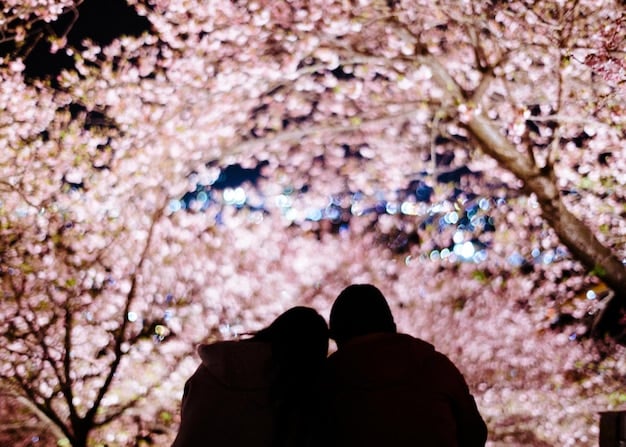Decoding Korean Drama Kiss Scenes: A 2025 Cultural Guide

Decoding Korean drama kiss scenes involves understanding the cultural nuances embedded within these moments, exploring how they reflect societal norms, character development, and storytelling techniques that continue to evolve, shaping viewer expectations and experiences in 2025.
Korean dramas, or K-dramas, have captivated audiences worldwide with their compelling storylines, stunning visuals, and, of course, their iconic kiss scenes. Decoding Korean Drama Kiss Scenes: A Viewer’s Guide to Cultural Nuances (Updated 2025) delves into the heart of these moments, unraveling the subtle yet significant cultural layers that often go unnoticed by international viewers, providing insight and context.
The Evolution of Kiss Scenes in K-Dramas
Kiss scenes in K-dramas have undergone a remarkable transformation over the years. What was once considered taboo or heavily regulated has evolved into a more expressive and natural portrayal of affection. This evolution reflects broader changes in South Korean society and its attitudes toward intimacy.
Early K-Drama Kisses: A Study in Restraint
In the early days of K-dramas, kiss scenes were often characterized by their demure and chaste nature. Open-mouthed kisses were rare, and even light pecks were carefully choreographed to avoid crossing any perceived boundaries of modesty. This restraint was largely influenced by conservative social norms and strict censorship regulations.
These early kiss scenes often served more as symbolic gestures rather than genuine expressions of passion. They were used to signify a shift in the relationship between the characters, a moment of realization or commitment, rather than a display of physical desire.
The Modern K-Drama Kiss: Embracing Nuance
As South Korean society became more open and globalized, K-drama kiss scenes began to reflect these changes. Modern K-dramas often feature more elaborate and passionate kisses, reflecting a broader acceptance and understanding of physical intimacy. However, even these more expressive scenes are still carefully crafted to align with cultural sensitivities and storytelling needs.
Today, K-drama kiss scenes are more nuanced and varied, ranging from gentle and sweet to intense and passionate. They play a crucial role in character development, plot progression, and overall emotional impact of the drama.
- Cultural Shifts: The liberalization of South Korean society has paved the way for more expressive kiss scenes.
- Artistic Expression: Modern K-dramas prioritize nuanced storytelling, using kiss scenes to enhance emotional depth.
- Viewer Expectations: Audiences now expect more realistic and engaging portrayals of romance.
- Global Influence: Exposure to international media has shaped the evolution of K-drama kiss scenes.
The evolution of kiss scenes in K-dramas mirrors the broader cultural shifts and artistic developments in South Korea. What was once a carefully guarded secret has now become a vital component of storytelling, offering a glimpse into the changing attitudes toward intimacy and romance.
Cultural Significance of Kiss Scenes
Beyond their aesthetic and entertainment value, kiss scenes in K-dramas hold significant cultural weight. They reflect societal values, norms, and expectations surrounding relationships and intimacy. Understanding these cultural nuances is essential for truly appreciating the depth and complexity of these scenes.
Confucianism and the Concept of “Nunchi”
Confucianism, with its emphasis on respect, hierarchy, and social harmony, has a profound influence on South Korean culture. This influence is evident in the way relationships are portrayed in K-dramas, including the portrayal of physical intimacy. The concept of “nunchi,” or the ability to read a room and understand unspoken cues, is particularly relevant in understanding kiss scenes.
In many K-dramas, characters carefully gauge each other’s feelings and intentions before initiating a kiss. This is not simply a matter of politeness; it is a reflection of the deep-seated cultural value of respecting boundaries and avoiding causing discomfort. A kiss is often seen as a significant step in a relationship, and it is approached with caution and consideration.
The Importance of Nonverbal Communication
Nonverbal communication plays a crucial role in K-drama kiss scenes. Facial expressions, body language, and subtle gestures often convey more meaning than words. Viewers are expected to pay close attention to these cues in order to fully understand the emotional context of the scene.
For example, a character’s hesitation or nervousness before a kiss can indicate their vulnerability and uncertainty. Conversely, a confident and assertive approach can signal their desire and commitment. These nonverbal cues add depth and complexity to the scene, making it more engaging and emotionally resonant.

Cultural significance shapes how kiss scenes are portrayed, emphasizing respect, nonverbal cues, and caution in expressing affection.
Common Tropes in K-Drama Kiss Scenes
K-dramas are known for their reliance on certain tropes, or recurring themes and motifs. Kiss scenes are no exception. While these tropes can sometimes feel predictable, they also provide a sense of familiarity and comfort for viewers. By understanding these common tropes, viewers can better anticipate and appreciate the nuances of K-drama kiss scenes.
The Accidental Kiss
One of the most enduring tropes in K-dramas is the accidental kiss. This often occurs when two characters stumble, trip, or otherwise find themselves in close proximity, resulting in an unexpected lip-lock. While this trope may seem contrived, it serves a specific purpose: to create a moment of tension and uncertainty, forcing the characters to confront their feelings for each other.
The accidental kiss is rarely portrayed as a passionate or sensual encounter. Instead, it is often awkward, clumsy, and filled with comedic relief. This reflects the cultural emphasis on avoiding impropriety and maintaining social decorum.
The “Fish-Eye” Kiss
The “fish-eye” kiss is another common trope in K-dramas. This involves one character staring intently at the other’s lips, often with a look of longing or desire. This technique is used to build suspense and anticipation, signaling that a kiss is imminent.
The “fish-eye” kiss can be both romantic and comedic, depending on the context. In some cases, it is used to convey genuine affection and attraction. In others, it is played for laughs, highlighting the character’s naiveté or awkwardness.
Common tropes such as accidental and “fish-eye” kisses offer predictability and hint at deeper character feelings.
Analyzing Different Types of K-Drama Kisses
Not all K-drama kisses are created equal. Just as there are different types of relationships, there are different types of kisses, each with its own unique meaning and impact. Analyzing these different types of kisses can provide valuable insights into the characters’ emotions and the overall narrative of the drama.
The Gentle Peck
The gentle peck is the most common type of kiss in K-dramas. It is often used to signify affection, comfort, or gratitude. This type of kiss is typically brief and chaste, focusing on the emotional connection between the characters rather than physical desire.
The gentle peck is often used in the early stages of a relationship, before the characters have fully committed to each other. It can also be used to reassure or comfort a partner during a difficult time.
The Passionate Embrace
The passionate embrace is a more intense and intimate type of kiss. It is often used to convey deep love, desire, or longing. This type of kiss is typically longer and more expressive than the gentle peck, involving more physical contact and emotional vulnerability.
The passionate embrace is often used in the later stages of a relationship, after the characters have overcome significant obstacles or challenges. It can also be used to reignite passion or resolve conflicts.

The “I Missed You” Kiss
This kiss comes after a period of separation or longing, emphasizing reunion and deep emotional bond. It is often characterized by intensity and relief.
- Gentle Peck: Shows affection and early relationship stages.
- Passionate Embrace: Conveys deep love later in the relationship.
- “I Missed You” Kiss: Expresses longing and renewed connection.
- Awkward Kiss: Highlights uncertainty and comedic relief.
Different kisses enhance plot and reflect the emotional connection between characters, portraying comfort or intense desire.
The “Kissing Master” Trend: A New Wave
Recently, a trend has emerged in K-dramas featuring characters who are portrayed as “kissing masters.” These characters are often confident, experienced, and skilled in the art of kissing. This trend reflects a growing acceptance and appreciation of female sexuality in South Korean society.
Breaking Stereotypes and Empowering Women
The “kissing master” trend challenges traditional stereotypes about women and sexuality. It portrays women as active agents in their own romantic lives, capable of initiating and enjoying physical intimacy without shame or guilt. This is a significant departure from the often passive and submissive roles that women have historically played in K-dramas.
These characters use their kissing skills not only to express their affection and desire but also to assert their independence and control. They are not afraid to take the lead in the relationship, and they are not afraid to express their needs and desires. This is an important step forward in the representation of women in K-dramas.
Impact on Viewer Perceptions
The “kissing master” trend has had a significant impact on viewer perceptions of romance and sexuality. It has encouraged viewers to question traditional gender roles and to embrace more open and honest communication about relationships.
Viewers are now more likely to expect and appreciate nuanced portrayals of female sexuality in K-dramas. They are also more likely to support and celebrate characters who challenge traditional norms and expectations.
This trend empowers women by portraying them as active and skilled in romantic relationships, influencing viewer perceptions.
Future of Kiss Scenes in K-Dramas: Predictions for 2025
Looking ahead to 2025, it is likely that K-drama kiss scenes will continue to evolve and adapt to changing social norms and viewer expectations. Several trends are likely to shape the future of these scenes.
Increased Diversity and Representation
One of the most important trends is the increasing demand for diversity and representation in K-dramas. Viewers are calling for more stories that feature characters of different ethnicities, sexual orientations, and gender identities. This demand is likely to influence the portrayal of kiss scenes, leading to more inclusive and representative depictions of love and intimacy.
In 2025, it is likely that K-dramas will feature more kiss scenes between same-sex couples, as well as more stories that explore the challenges and joys of intercultural relationships. It is also likely that K-dramas will feature more characters with disabilities, and that these characters will be given the opportunity to express their love and desire in meaningful ways.
Greater Emphasis on Consent and Respect
Another important trend is the growing awareness of the importance of consent and respect in romantic relationships. Viewers are increasingly critical of K-dramas that portray non-consensual or coercive behavior as romantic or desirable. This criticism is likely to influence the portrayal of kiss scenes, leading to a greater emphasis on communication, boundaries, and mutual respect.
In 2025, it is likely that K-dramas will feature more scenes that explicitly address the issue of consent, and that these scenes will be portrayed in a responsible and sensitive manner. It is also likely that K-dramas will feature more characters who actively challenge and reject non-consensual behavior.
Forecasting changes suggests diversity, respect, and realistic portrayals will shape future kiss scenes, integrating varied identities and sensitivities.
| Key Point | Brief Description |
|---|---|
| 🎭 Evolution of Kisses | From restrained to more expressive, mirroring social changes. |
| 💖 Cultural Nuances | Reflecting Confucian values and the importance of ‘nunchi’. |
| ⭐ Common Tropes | Including accidental kisses and the “fish-eye” gaze. |
| 🗝️ Future Trends | More diversity, consent, and realistic portrayals. |
Frequently Asked Questions
▼
Early K-drama kiss scenes were reserved due to conservative social norms and strict censorship regulations. This restraint was influenced by Confucian values, prioritizing modesty and avoiding displays of overt intimacy.
▼
“Nunchi” is the ability to read social cues and understand unspoken feelings. In kiss scenes, characters often use “nunchi” to gauge consent and emotional readiness before initiating physical contact.
▼
Common tropes include the accidental kiss, where characters stumble into each other, and the “fish-eye” kiss, where one character stares intently at the other’s lips, building anticipation.
▼
Kiss scenes have become more expressive and varied, reflecting growing social acceptance of more intimate portrayals. Modern K-dramas often showcase more elaborate and passionate kisses compared to earlier, more demure scenes.
▼
By 2025, expect increased diversity and representation in kiss scenes, along with a greater emphasis on consent and respect. Stories will likely feature a wider range of identities and relationships.
Conclusion
Decoding Korean Drama Kiss Scenes: A Viewer’s Guide to Cultural Nuances (Updated 2025) reveals that beyond entertainment, these scenes reflect evolving societal norms, cultural values, and artistic trends. Understanding these nuances enriches the viewing experience, providing deeper insight into the relationships and narratives presented in K-dramas.



![Unveiling the Layers of [Drama Name]: A Comprehensive Review Unveiling the Layers of [Drama Name]: A Comprehensive Review - Cover Image](https://oramacast.com/wp-content/uploads/2025/07/oramacast.com_5_1752083833_cffa9fe7_cover-360x180.jpg)
![Unveiling the Layers of Emotional Depth and Narrative Impact in [Drama Title] Unveiling the Layers of Emotional Depth and Narrative Impact in [Drama Title] - Cover Image](https://oramacast.com/wp-content/uploads/2025/07/oramacast.com_5_1752083731_0009d956_cover-360x180.jpg)
